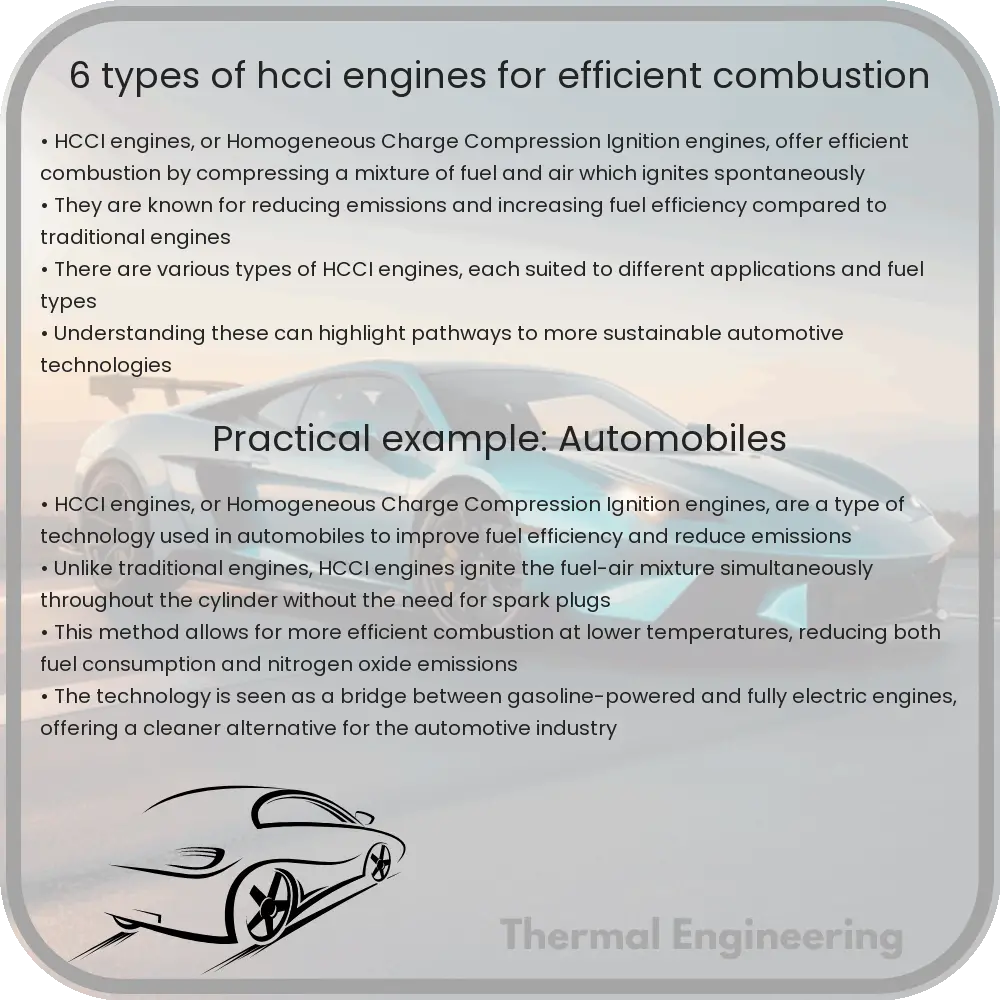Learn about Homogeneous Charge Compression Ignition (HCCI) engines, a blend of gasoline and diesel technologies enhancing efficiency and reducing emissions.

Understanding Homogeneous Charge Compression Ignition (HCCI) Engines
Homogeneous Charge Compression Ignition (HCCI) engines represent a significant advancement in combustion technology. These engines combine characteristics of gasoline engines (spark ignition, SI) and diesel engines (compression ignition, CI), aiming to improve efficiency and reduce emissions. In an HCCI engine, a mixture of fuel and air is compressed to the point of ignition without the need for a spark plug. This article explores six distinct types of HCCI engines that enhance efficient combustion.
1. Traditional Gasoline-Based HCCI Engines
These engines utilize standard gasoline, similar to what is used in conventional SI engines. The key difference is in the engine’s ability to compress the gasoline-air mixture to a point where it ignites spontaneously. Gasoline-based HCCI engines often employ variable valve timing and other controls to manage the combustion process, making them more adaptable to different operating conditions.
2. Diesel-Based HCCI Engines
While traditional diesel engines use direct injection and high compression to ignite the fuel, diesel-based HCCI engines premix the air and diesel fuel before compression, leading to a cleaner and more controlled combustion process. These engines can significantly reduce nitrogen oxide (NOx) and particulate matter (PM) emissions compared to conventional diesel engines.
3. Ethanol and Other Alcohol-Based HCCI Engines
Alcohols like ethanol have higher octane ratings and a greater resistance to engine knock, making them advantageous for HCCI combustion. Ethanol-based HCCI engines benefit from the fuel’s properties by achieving higher efficiency and lower carbon monoxide (CO) and hydrocarbon (HC) emissions relative to gasoline HCCI systems.
4. Natural Gas HCCI Engines
Natural gas, primarily consisting of methane, provides a high octane fuel source which is ideal for spontaneous ignition in HCCI engines. These engines are particularly appealing for commercial fleet vehicles due to the abundance and lower cost of natural gas, coupled with significant emission reductions.
5. Dual-Fuel HCCI Engines
Dual-fuel HCCI engines employ a combination of two different fuels, which usually include a primary high-octane fuel like gasoline or natural gas, and a secondary direct-injected high-cetane fuel such as diesel. This setup allows for greater control over the ignition and combustion processes, enhancing engine efficiency and reducing emissions across various operating conditions.
6. Hybrid HCCI Engines
Integrating HCCI technology with electric hybridization leads to hybrid HCCI engines. These engines use electric motors to assist the engine during low power demands, allowing the HCCI engine to operate more frequently within its optimal efficiency range. This type of engine is particularly efficient in stop-and-go traffic, substantially reducing both fuel consumption and emissions.
In conclusion, HCCI technology presents a promising pathway to achieving higher engine efficiencies and reduced pollutant emissions. Each type of HCCI engine offers distinct advantages and is suited to different applications, making HCCI a versatile and environmentally friendly option in the landscape of internal combustion engines.